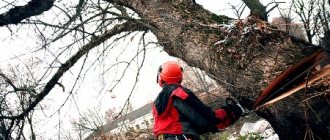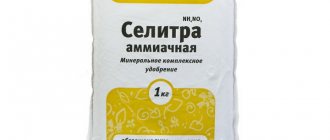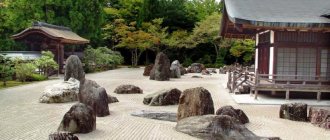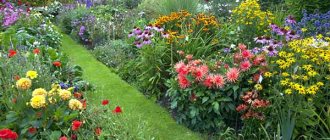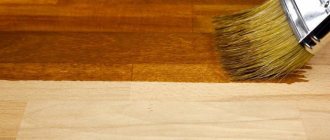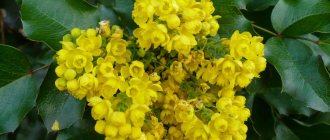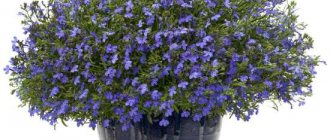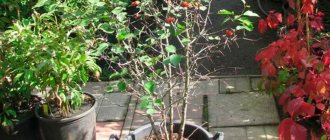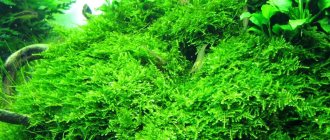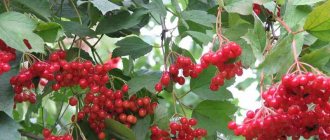Advantages and Disadvantages of Weeds
Weed classification
Weed prevention
Useful tips for getting rid of
Weeds are wild-growing representatives of the plant world that grow quickly and harm useful crops. They block the sun and deplete the soil, absorbing beneficial microelements and moisture. There are more than 250 thousand plant species on the planet, 3% of which are wild.
Types and classification of weeds in the garden
The main biological differences of weeds:
- Lifespan.
- Reproduction method.
- Nutrition.
According to their life span, plants are divided into perennial and minor. Perennials grow in one place for 4-5 years in a row. When their seeds ripen, the stem and the entire above-ground part die off, while the underground part continues to develop. Based on the structure of the root system, the following perennial weeds are distinguished:
- taproot - a powerful root in the form of a rod penetrates the soil to a depth of 3 m, divides, forming new shoots;
- fibrous root;
- bulbous;
- tuberous.
Biennial weeds (for example, yellow and white clover, curly thistle) during the first year of life develop a powerful root, from which stems grow in the second year. After fruiting, the plant dies completely. Depending on conditions, some species can develop both as biennials and as annual wintering ones.
Different types of annual weeds have the following life expectancy:
- ephemera - up to two months, producing several generations in one season;
- early and late spring varieties germinate in early spring or late spring, stop developing simultaneously with cultivated plants, and produce only 1 seed harvest per year;
- winter - germinate in late summer or early autumn and next year ripen early and clog the soil.
Annual species reproduce by seeds, and perennial species reproduce by seeds and vegetatively. The reproduction rate of weeds is high. Each can produce tens of thousands of seeds that remain viable while in the soil for 5 or more years, and with vegetative propagation (shoots, roots, parts of rhizomes, stems, tubers, etc.) they develop even faster than from seeds. Creeping weeds grow rapidly, but rhizomatous and root-sprouting weeds are considered the most malicious.
Based on their feeding method, weeds are divided into the following groups:
- Non-parasitic. They develop independently.
- Parasitic. They do not have chlorophyll grains, leaves, green color and cannot synthesize organic matter. They feed on the plastic substances of green plants, parasitizing their roots or stems.
- Semi-parasitic. They have chlorophyll in their leaves and can develop independently, but they feel better when they stick to the roots of another plant and use its nutrients.
Covering materials
The method is good for small areas, but for other more massive areas it will be cost-effective.
Today, there are also covering materials in the form of black film, which can also be used as a means of preventing grass from growing on the site. This film is stretched in the garden and cross-shaped cuts are made in places where cultivated plants will grow, so weeds will no longer grow in closed areas.
Covering sheets are usually black and vary in thickness. It is to combat weeds that very dense materials are used, through which sunlight does not penetrate. The advantage of such canvases is that a crust does not form under it from drying out, the soil is always moist and clean, and pests are visible on the surface.
Therefore, it is recommended to use it where small and malicious weeds are found, and also where you plan to make beds, for example, under tomatoes, strawberries, herbs, etc.
Covering material under strawberries Source static-eu.insales.ru
The most common weeds
1 hectare of land can contain 50 million seeds of various weeds. Among them are the following:
- decorative (convolvulus, woodlice, field violet);
- edible (sweetweed, quinoa, wild rose);
- poisonous and dangerous for animals and humans (hogweed, common pickleweed);
- honey plants (saltbeard, thistle).
The pernicious weed Canadian small petal is grown as a good essential plant - it contains limonene. Weeds in the garden can attract beneficial insects (clover, red dandelion) and repel pests (thistle, ivy), serve as green fertilizer (alfalfa, nettle), and improve the quality of compost (comfrey, dandelion). But if they grow in a garden bed next to garden crops, they can not only reduce the yield, but also destroy the crops. The general rule in the fight against weeds is not to allow them to bloom.
Each type of garden weed inhibits neighboring seedlings in its own way, so to combat them you need to know their biological characteristics.
Creeping wheatgrass
One of the most tenacious perennial weeds. The 1.5 m long root releases substances that slow down the growth of nearby plants. To develop, wheatgrass needs 2 times more water and nutrients than most cultivated plants.
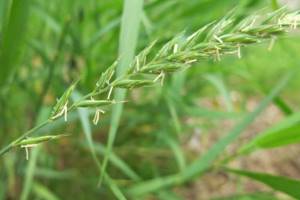
Every 2-3 cm on its root there are buds from which new shoots grow. Propagated by seeds. Damages potato plantings by piercing young tubers. It is better to get rid of wheatgrass by weeding in August, at which time its ear ripens and the plant weakens.
Field bindweed
Other names: birch, dodder. The roots of an adult bindweed penetrate 2-3 m deep into the ground, the shoots from the buds quickly stretch upward. Long stems entwine vegetables and herbs in the garden and can destroy them. Bindweed quickly fills free space, especially in dry summers. 1 plant can produce more than 500 seeds.
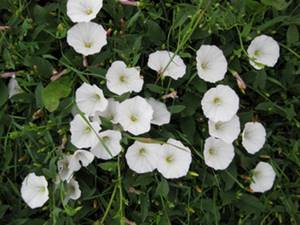
The bindweed is removed by cutting off its upper part 4-5 times a season. This depletes the root. When destroying bindweed, one must take into account that all its parts are poisonous and can cause vomiting, stomach pain, diarrhea, and provoke congestion in the kidneys.
Shchiritsa thrown back
Belongs to the amaranth family, differs from cultivated amaranth in its short stature (up to 1 m), smaller leaves and greater unpretentiousness. Propagated only by seeds, which remain viable in the soil for more than 20 years. It produces 2 harvests per season, covering areas with a continuous carpet and suppressing the seedlings of cultivated plants.
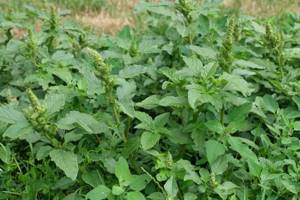
Cross-pollinating with amaranth harms the purity of the variety. Young acorn leaves can be added to soups or salads (boiled), and the green mass is fed to pigs and poultry.
Purslane
The red-brown stem and oval, bright green leaves quickly cover large areas with a carpet. The first flowering is in early June; in just one season, purslane produces seeds 3-4 times, and they retain vitality in the soil for 10 years. Any part of the plant can easily take root in poor soils if there is enough moisture. A waxy coating on the leaves protects against the effects of garden chemicals.

The most effective against it is a solution of Roundup with other herbicides (for example, Octigen, Lapis Lazuli) and weeding. Young shoots and leaves of cultivated (not wild) purslane are used in cooking.
Ambrosia artemifolia
The taproot penetrates 4 m deep into the soil, greatly depleting it, taking up phosphorus, nitrogen and water. Beets, carrots, pumpkins, and beans will dry out near the ragweed, especially in a dry spring. Weeds create dense shade and can grow up to 1.7-2 m. Artemisia ragweed is an annual quarantine weed that, even in minimal quantities, causes severe allergies, including asthma attacks.
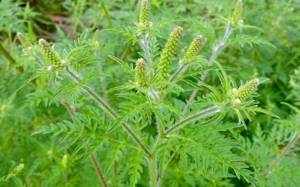
If you cut it at the beginning of development, many stems are formed and the bush becomes lush. Therefore, it is necessary to mow ragweed before flowering, then it will not have the strength to grow.
Thistle (thistle)
On the long (4 m) taproot and horizontal lateral roots, renewal buds are formed, sprouting even from a depth of 1.5 m. In 3 years, the root system of thistle can develop up to 5-7 m. It is propagated by seeds. They ripen at the end of summer, are easily carried by the wind over long distances and can germinate in the fall. Thistle develops slowly and can grow up to 1.5 m.
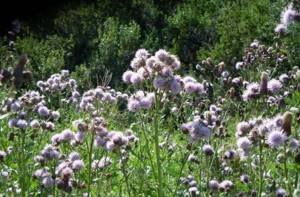
Its stem is covered with stiff hairs and its leaves are covered with thorns, making weeding difficult. Weevils settle on thistle and destroy young vegetable shoots. Beetroot suffers the most.
Spurge
Euphorbia vine is a hardy perennial plant. The weed blooms beautifully, but is poisonous to animals, and its milky sap causes irritation on human skin. It spreads slowly, because the seeds fall near the mother bush. Like roots, they can remain dormant for several years in the absence of suitable conditions.
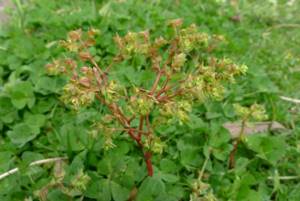
The weed can choke out any vegetables, but it causes the greatest harm to grain crops; it can destroy 30-50% of pea plantings, infecting it with rust, the fungus of which overwinters in the roots of milkweed. It is removed by mechanical and chemical methods.
Thistle
The most common biennial species are curly, spiny and drooping. The thistle looks decorative; its nectar attracts many insects useful to the garden. It is difficult to get rid of thistles due to the abundance of sharp thorns and thorns, especially if it has grown to 1-2 m.
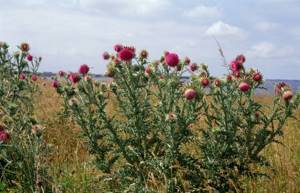
The plant is cut off at the base. If this is done frequently, the taproot becomes depleted and gradually dries out.
Chemical control measures
How to water the grass so that it does not grow on the plot is the most basic question that all gardeners ask themselves with limited time for physical labor. To introduce something so that you water it once and nothing grows except your favorite carrots or radishes...
Here, too, not everything is as simple as it seems at first glance - there are a number of subtleties that you need to know. This method of weed control should be used only in extreme cases, for example, if the site was previously abandoned and you need to eradicate all the grass or unnecessary shrubs. Many experts also recommend using it along the edges of garden plots and between beds, i.e. in those places where the main crops do not grow, and weeds appear.
Herbicides are pesticides of a chemical nature aimed at destroying weeds.

Treatment with herbicides Source narod.hozvo.ru
When deciding what to water the grass to prevent it from growing in the area, many immediately think of herbicides, but few people know that there are two groups of herbicides:
- Selective herbicides are substances of chemical origin that selectively act on a certain group of weeds, cultivated plants and other types of weeds; they do not destroy.
- Continuous action herbicides that completely destroy all grass and even cultivated grass (favorite carrots, radishes, potatoes). These herbicides are used exactly where all the weeds need to be destroyed, or they can be used by studying the instructions for the drug in advance, before sowing or after harvesting the crop.
Lawn weeds
If weeds appear, you need to get rid of them as soon as possible, because they spoil the appearance of the lawn:
- do not allow lawn grass to develop normally, because they have a more powerful root system and draw out moisture and nutrients;
- contribute to the emergence of pests, diseases and lawn degeneration;
- They multiply quickly - by seeds and by mowing.
Weeds are difficult to get rid of, especially with low, creeping rosette plants, because their roots intertwine with the roots of the grass and form a dense turf layer. The danger of lawn infection is high in the first 2 years of its life. Later, when a dense grass stand forms, it will become much more difficult for incoming seeds to cling to the soil.
To get a beautiful lawn, the herbicide Lontrel is used, and on lawns sown with cereals, the combined drug Propolol is used; within 3-4 weeks they ensure the death of more than 100 types of weeds, including malicious ones - shepherd's purse, yellow sow thistle, field grass.
Bluegrass
Annual. Grows well in lowlands on compacted soils. It can be distinguished from meadow bluegrass, used in lawn grasses, only in June, when it begins to bloom, forming unsightly spots on the lawn, like moss. Spike-shaped inflorescences produce a large sowing of seeds, and the fibrous root gradually grows in breadth.
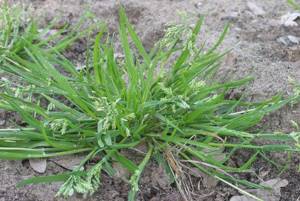
You can get rid of bluegrass like this: when the grass on the lawn reaches 7-8 cm, mow it to 4-5 cm.
Dandelion
Seeds placed in the soil before sowing the lawn will take several years to germinate. If the soil is loose, the fleshy dandelion root can be removed intact. Its particles will remain in the dense soil and will germinate.
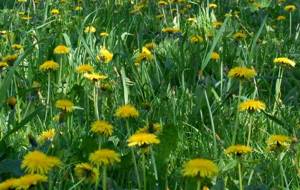
Dandelion roots have a large supply of nutrients, so you can deal with it through repeated use of herbicides (in spring and early summer).
Creeping buttercup
It produces many root shoots, from which new plants quickly form. Prefers moist soil. The buttercup is easily removed with its roots using a garden fork, after which, in cool weather, the lawn is aerated and fed.
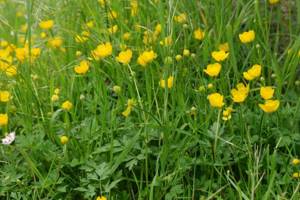
Plantain
The broad oval leaves of plantain stand out on the lawn. The perennial weed reproduces by seeds (up to 320 thousand seeds per plant), prefers dense, moist soil, but also survives in drought.
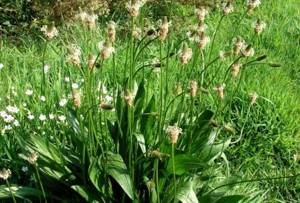
Its strong short rhizome is easy to completely dig out from loose soil. To decompact the soil, it is pierced with a pitchfork to allow air to enter and covered with 1 cm of sand once every 2-3 years.
Clover
Creeping shoots quickly take root, leading to yellowing of the lawn grass, and when it freezes, to bald spots. Dry soil poor in nitrogen suffers more. To remove the clover root, you need to thoroughly moisten the soil near the bush and pry it off with a narrow spatula.
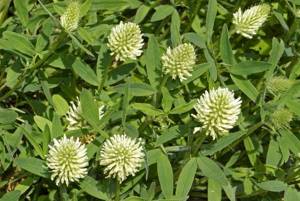
Fertilizing (5-6 times per season), which strengthens the lawn, will help prevent re-reproduction.
Veronica filamentous
Ground cover plant. Suitable for garden decoration, but on lawns thin shoots quickly spread and clog the grass. It loves poor, moist soils, but survives in dry soils, quickly recovers after freezing, and reacts well to herbicides only at the budding stage.
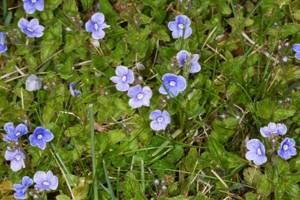
It is difficult to dig up filamentous speedwell. It should be raised with a rake every time before mowing the lawn, and the area should be fertilized regularly.
Folk remedies for weeds
How to water the grass to prevent it from growing is decided strictly individually and taking into account your interests. Here you can use specialized science-based approaches or folk remedies. For example, sprinkle salt on a weed plant, but salt can also eat cultivated plants, so you need to carefully treat it with a solution or water the grass so that it does not grow with diesel fuel or alcohol, especially in a cucumber bed.
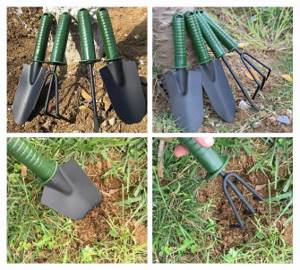
Traditional methods of weed control Source dhresource.com
When choosing how to remove grass from a plot using folk remedies , people most often pay attention to the following:
- Method 1 is a hoe, hoe, shovel, trimmer, i.e. mechanical, in which weeds are manually removed, and subsequently they do not interfere with the growth of vegetables and berries.
- Method 2 - the same saline solution, but if salt licks or malt predominate in your area, then it’s better not to, there’s no need for extra salt.
- Method 3 is to use an effective means of removing grass from the area, such as ameliorant, i.e. change the acidity of the soil, for example, if biting midge or horsetail grows on the site, this means that the soil is acidic, which means you need to use either semi-rotted horse manure (horse) with neutral acidity, or ameliorants (dolomite flour, lime, marl). If the soil is highly alkaline, use gypsum.
Weeds that are used in folk medicine for treatment
Many weeds are used in folk medicine. Of the above, medicinal drugs include the following:
- wheatgrass - due to the presence of silicic acid, it is used in the treatment of bronchi, rheumatism, gout and to improve metabolism;
- thistle - heals the liver and enhances sexual activity;
- plantain - heals wounds without allowing suppuration;
- clover - helps to dissolve lumps in mastopathy.
Ivy bud, burdock, dandelion and dozens of other weeds have medicinal properties.
Cornflower blue
Found only in soil containing crushed stone. Reproduces only by seeds. Cornflower flowers contain brevicepsin, which has a pronounced vasodilating effect, and is used as a mild diuretic and laxative for gastrointestinal diseases (in collections) and in home cosmetology.
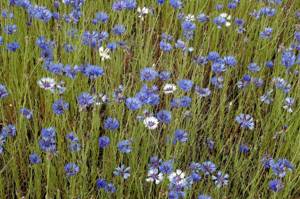
Nettle
The leaves are rich in ascorbic acid and carotene. Nettle has a hemostatic, anti-inflammatory and choleretic effect, restores strength, improves blood composition (increases the number of red blood cells and reduces the amount of sugar), normalizes fat metabolism. The seeds are useful for men to increase potency.
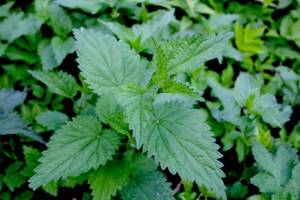
Horsetail
Used as an anti-inflammatory and hemostatic agent. Horsetail reduces blood pressure, stimulates the adrenal cortex, and helps eliminate lead from the body. When used as a diuretic, potassium is not washed away. Contains silicon, so decoctions of raw materials help improve hair growth.
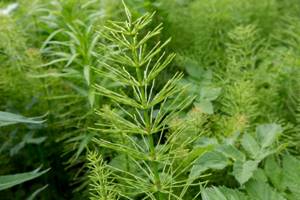
knotweed
Flowers and the top 30-40 cm of the plant are used. Most often, knotweed (knotweed) is used to crush kidney stones and remove them, as well as excess salts in the urine. The weed is useful for women's health: for bleeding after miscarriages and childbirth, for iron deficiency anemia as a result of heavy menstruation, for increasing the tone of the uterine walls and restoring reproductive function. Knotweed leaves contain pectin, which removes poisons from the body.
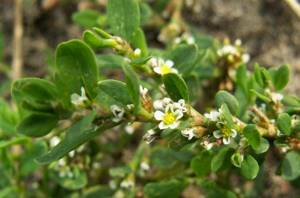
Rate this article:
Briefly about the main thing
There are a wide variety of weed species that need to be controlled correctly and efficiently. To competently destroy unnecessary herbs on your site, you need to know their classification, understand their biology and choose the right method to combat them.
Mechanical and biological methods are good because they are environmentally friendly - poisons are not used here, i.e. your site will be clean and well-groomed, and the vegetables and berries will be healthy. However, a lot of manual labor is required.
Chemical control measures are less labor-intensive, but also not always environmentally safe - they can pollute or over-sterilize the soil, so they should be used in emergency cases.
People's advice shows the greater effectiveness of weeding and the use of saline solutions and ameliorants.
But in any case, there is no universal advice, and what to water the grass to prevent it from growing must be decided on the spot.
Ratings 0
Hemlock spotted
This plant of the Apiaceae family looks quite harmless in appearance - a thin branched stem with small feathery leaves of “parsley” and the same small white flowers collected in inflorescences-baskets. Distinctive signs can be dark spots on the bottom of the leaves and stem, as well as an unpleasant “mouse” smell when rubbing the leaves in your hands.
Absolutely all parts of hemlock are poisonous to both animals and people. Back in Ancient Greece, hemlock extract was an official poison used in executions. Today it is successfully used as a medicinal plant, but subject to the strictest safety measures during its preparation, as well as in the presence of very serious pharmacological knowledge.
An ordinary summer resident should know that the poisonous properties of the plant are determined by the presence of a large number of toxic alkaloids in it, the most dangerous of which is horse meat, which causes paralysis of the nervous system - and the achenes of this plant are richest in them before they are fully ripened and leaves before flowering begins.
An inexperienced gardener may confuse hemlock leaves with parsley, its seeds with anise, and its rhizome with horseradish. When the plant juice gets on the skin, redness and burning are observed.
When consuming any parts of the plant for food, the following symptoms of varying severity may be observed:
- increasing headache and dizziness,
- pale skin,
- increased salivation,
- nausea or vomiting
- diarrhea,
- constriction of the pupils, blurred vision,
- shortness of breath and tachycardia,
- convulsions,
- progressive weakness up to complete paralysis (it moves from the feet up the body, which is why it is called “ascending”),
- in extreme cases, death from suffocation.
What to do in case of poisoning as first aid? Drink a lot of water, rinse the stomach with an aqueous solution of potassium permanganate (1 g per 1 liter of water), take activated carbon (1 tablet for every 10 kg of weight), inject vitamins B6 and B12 intramuscularly, and saline laxatives.
In all cases without exception, in case of poisoning by any poisonous plants, after providing first aid, you must consult a doctor.
Precautionary measures when detecting hemlock on the site: limit access to it for children and animals, weed out the plant only with gloves, do not taste its parts, do not store the weeded weeds, but destroy them immediately.
